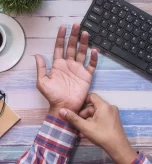At Simply Well Chiropractic in Cincinnati, we understand how debilitating bursitis can be. That’s why we are excited to offer SoftWave Therapy as a bursitis treatment in Cincinnati. This innovative, non-surgical treatment option based on advanced shockwave technology targets the root causes of pain without the need for invasive procedures or reliance on prescription medications.
Understanding Bursitis
Bursitis is a common and often painful condition that affects active athletes, desk-bound professionals, and retirees. Characterized by inflammation and pain in the bursae—small, fluid-filled sacs that cushion the bones, tendons, and muscles near joints—bursitis can severely disrupt daily activities and reduce quality of life. These sacs are critical in reducing friction and cushioning the pressure points between the body’s moving parts. When they become inflamed, it results in pain and restricted movement, significantly affecting an individual’s ability to perform everyday tasks comfortably.
Common Causes of Bursitis
Bursitis can arise from several factors, each contributing to the inflammation and discomfort experienced by sufferers:
- Repetitive Motion or Overuse: Engaging in repetitive activities, especially those associated with certain sports or occupations, can put undue stress on the bursae. Common examples include throwing a baseball, lifting objects repeatedly, or even performing tasks like gardening or painting.
- Acute Injuries: Direct impacts or trauma to a joint—such as a fall, a bump, or an accident—can cause immediate and severe inflammation of the bursae.
- Prolonged Pressure: Continuous pressure on a particular area, such as sitting on a hard surface for long periods or kneeling frequently, can irritate and inflame the bursae, especially those in the knees or hips.
- Age-related Factors: As we age, our tendons tend to lose elasticity and are more susceptible to injury. This increased vulnerability can lead to bursitis, particularly in individuals who remain physically active without adjusting their activity levels to their body’s changing needs.
- Systemic Diseases: Certain systemic conditions, such as rheumatoid arthritis, gout, and diabetes, can predispose individuals to developing bursitis. These diseases can alter the body’s normal inflammatory response or lead to deposits within the bursae, triggering inflammation.
Affected Areas: Where Bursitis Can Strike
When bursitis impacts the body, it typically manifests as pain, swelling, tenderness, and restricted mobility. The discomfort tends to intensify with ongoing pressure or movement. Therefore, it is crucial to manage bursitis promptly to mitigate further irritation and facilitate a faster healing process.
Here are some of the most common areas where bursitis can develop:
- Shoulders: The shoulder joint has several bursae, but the subacromial bursa is the most commonly affected. This bursitis can make movements like reaching overhead or behind the back painful and difficult.
- Elbows: Often referred to as “tennis elbow,” bursitis in this area typically affects the olecranon bursa at the tip of the elbow. It’s common among those who engage in activities requiring frequent bending and extending of the elbow.
- Hips: One of the most frequent sites of bursitis is the hip, particularly in the trochanteric bursa, which lies on the outer part of the hip. This type can cause significant discomfort when lying on the affected side, walking, or climbing stairs.
- Knees: Known as “prepatellar bursitis” or “housemaid’s knee,” inflammation in the knee affects the bursa located right above the kneecap. It’s often seen in individuals who kneel for extended periods, like gardeners or carpet layers.
- Ankles: Bursitis in the ankle usually involves the retrocalcaneal bursa, situated between the heel bone and the Achilles tendon. This type is common among runners and can be exacerbated by poorly fitting footwear.
The Innovative Approach to Bursitis: SoftWave Therapy
SoftWave Therapy uses high-energy acoustic waves to induce a process known as mechanotransduction, in which cells respond to mechanical stimuli by initiating chemical changes. These acoustic waves travel faster than the speed of sound and can significantly enhance the body’s natural healing abilities. The therapy works by:
- Increasing Blood Flow: Enhanced circulation brings essential nutrients and oxygen to the affected areas, facilitating faster healing.
- Stimulating Cellular Repair: Shockwaves trigger biological responses at the cellular level that lead to tissue regeneration.
- Reducing Pain: By directly influencing nerve fibers, shockwaves can decrease pain sensation, providing immediate relief.
- Promoting Collagen Production: Essential for rebuilding tendons and other connective tissues, collagen production is stimulated, enhancing the structural integrity of the joints.
Benefits of SoftWave Therapy for Bursitis
SoftWave Therapy is rapidly becoming a preferred treatment option for bursitis due to its numerous benefits that not only alleviate symptoms but also contribute to a healthier, more active lifestyle without the drawbacks of more invasive procedures. Here’s a closer look at the key advantages of using SoftWave Therapy in the treatment of bursitis:
Speedy Recovery and Enhancement of the Body’s Natural Healing Abilities
One of the most significant benefits of SoftWave Therapy is its ability to expedite the healing process. By using unfocused shockwaves, this therapy stimulates the body’s natural regenerative mechanisms. Patients typically experience a quicker return to their daily activities and a reduction in chronic discomfort.
Decreased Need for Medications, Offering a Drug-Free Alternative
SoftWave Therapy serves as an effective drug-free alternative to traditional treatment methods, which often rely on medications to manage pain and inflammation. By reducing the need for anti-inflammatory drugs and pain relievers, SoftWave Therapy minimizes the potential side effects associated with long-term medication use, such as gastrointestinal issues, cardiovascular risks, and dependency.
Improvement in Life Quality by Reducing Pain and Enhancing Mobility
Bursitis can severely impact an individual’s quality of life by limiting mobility and causing persistent pain. SoftWave Therapy addresses these issues directly by reducing inflammation and pain at the source. As the treated areas heal and the pain subsides, patients find significant improvements in mobility and flexibility. This enhancement in quality of life is a key outcome of SoftWave Therapy, helping patients regain their independence and enjoy a more active lifestyle.
Safety and Non-invasiveness of the Treatment
SoftWave Therapy is a safe and non-invasive treatment option, which means it does not require surgery, cuts, or injections. This reduces the risks associated with invasive procedures, such as infections, complications from anesthesia, and lengthy recovery times. The non-invasive nature of the treatment also means that there is no downtime required after a therapy session. Patients can continue with their day immediately following treatment.
How SoftWave Differs from Other Shockwave Therapies
SoftWave Therapy stands out from other forms of shockwave therapy due to its use of unfocused shockwaves, which offer several distinct advantages:
- Deeper Tissue Penetration: Unlike focused shockwave therapy (FSWT) and radial shockwave therapy (RSWT), SoftWave’s unfocused shockwaves penetrate deeper and cover a broader area, making them ideal for treating larger joints and deeper tissue problems.
- Broader Impact: The unfocused nature of the waves ensures that a larger treatment area is addressed in each session, which is particularly beneficial for complex or extensive areas of inflammation.
- Fewer Sessions Needed: Patients often experience significant improvements with fewer treatments compared to other shockwave modalities, which can require more frequent sessions.
- Increased Comfort: SoftWave therapy is generally more comfortable for patients, as the unfocused waves distribute energy over a wider area, reducing the intensity of sensation felt during the treatment.
Traditional Treatments for Bursitis
While innovative treatments like SoftWave Therapy provide non-invasive options, traditional non-invasive approaches to managing bursitis include:
Rest and Immobilization
One of the simplest yet most effective treatments for bursitis involves resting the affected joint and avoiding activities that exacerbate the condition. Temporarily immobilizing the joint with a brace or splint can help reduce inflammation and prevent further irritation.
Cold Therapy
Applying ice packs to the inflamed area is a common initial treatment for reducing swelling and numbing pain. Ice therapy should be applied several times a day for 15-20 minutes each time during the first few days of experiencing symptoms.
Physical Therapy
Physical therapy can be instrumental in recovering from bursitis. A physical therapist can teach exercises that strengthen the muscles around the joint, enhance flexibility, and reduce the likelihood of future flare-ups. Physical therapy also often includes modalities like ultrasound, manual therapy, and electrical stimulation to help reduce inflammation and pain.
Lifestyle and Ergonomic Adjustments
Modifying activities that aggravate the condition is often necessary. Ergonomic changes at work or during activities and using protective pads when kneeling or performing tasks that strain the joints can help prevent recurrent episodes of bursitis.
The SoftWave Therapy Procedure
SoftWave Therapy offers a straightforward and efficient process for treating bursitis. Here’s a detailed step-by-step guide to what you can expect during and after a SoftWave Therapy session at Simply Well Chiropractic in Cincinnati:
Preparation
- Initial Consultation: Before beginning treatment, you will have a consultation with Dr. Faith to confirm that SoftWave Therapy is suitable for your specific case of bursitis.
- Treatment Planning: Dr. Faith will outline the areas to be targeted based on your symptoms and previous medical history.
- Pre-Treatment Preparation: You may be asked to remove clothing or jewelry around the affected area to allow unimpeded access to the site of inflammation.
Procedure Execution
- Applying the Conductor Gel: Gel is applied to the treatment area to help transfer the shockwaves effectively and to minimize discomfort.
- Device Positioning: The SoftWave device is carefully positioned on the treatment area. The therapist will adjust the device to ensure the shockwaves are directed precisely at the inflamed bursae. You will be asked to identify where the problem areas are as the applicator rolls over your skin. In unaffected areas, you will not feel anything. When the applicator rolls over the inflamed bursae area, you will feel a little pain. This indicates that the treatment is working.
- Shockwave Delivery: The device emits shockwaves in a controlled manner. You will feel pulses, which may cause mild discomfort, but this is generally well tolerated. The intensity can be adjusted to ensure your comfort throughout the session.
- Duration: The entire process typically takes between 10-15 minutes.
Post-Procedure Expectations
- Immediate Aftercare: After the session, you can resume your daily activities almost immediately. There’s no downtime required, making it a convenient option for those with active lifestyles.
- Monitoring Symptoms: You might notice a reduction in pain and an improvement in mobility shortly after treatment. However, the full benefits of the therapy may be realized after a few sessions.
- Follow-Up Appointments: Additional sessions may be necessary to achieve optimal results. Your therapist will schedule follow-ups based on your individual response to the treatment.
Potential Side Effects of SoftWave Therapy
While SoftWave Therapy is safe and non-invasive, some patients may experience minor side effects, which are typically short-lived and resolve on their own. These may include:
- Temporary Discomfort or Pain: Some patients report a mild sensation of pain or discomfort during the shockwave delivery, akin to a flick or snap on the skin.
- Swelling and Redness: The treated area may show slight swelling or redness immediately following the procedure. This usually subsides within a few hours.
- Bruising: In rare cases, minor bruising may occur, especially in sensitive areas, but this is uncommon and heals quickly.
It is important to discuss any concerns or questions with Dr. Faith before starting treatment. She can provide additional guidance on what to expect based on your specific condition and health profile.
Who Can Benefit from SoftWave Therapy?
SoftWave Therapy is a versatile and effective treatment option that can provide significant benefits for a variety of patients suffering from bursitis. This non-invasive therapy is particularly well-suited for individuals who are looking for alternatives to traditional medical treatments that involve drugs or surgery. Here are the ideal candidates who might benefit most from SoftWave Therapy:
Chronic Bursitis Sufferers
Individuals who experience chronic bursitis often find that conventional treatments such as icing, rest, and anti-inflammatory medications no longer provide sufficient relief. SoftWave Therapy can be particularly beneficial for these patients, as it targets the underlying causes of inflammation and pain at a cellular level, encouraging natural healing processes that can lead to lasting relief.
Those Who Have Not Found Success with Other Therapies
Patients who have tried various treatments without success may find SoftWave Therapy to be an effective alternative. This includes those who have undergone physical therapy, used prescription medications, or even received corticosteroid injections without achieving the desired outcomes. SoftWave Therapy’s approach to stimulating the body’s own healing mechanisms provides a new avenue for treatment that might be more effective for individuals resistant to conventional methods.
Patients Seeking Non-Invasive Treatment Alternatives
SoftWave Therapy is an excellent option for patients who prefer to avoid the risks and downtime associated with surgical interventions. As a non-invasive treatment, SoftWave Therapy does not require incisions, anesthesia, or a recovery period. This makes it a safe choice for elderly patients, those with medical conditions that make surgery risky, and individuals who cannot take time off from work or daily activities for a surgical recovery.
Additionally, since SoftWave Therapy does not involve the use of drugs, it is suitable for patients who may be prone to the side effects of pain medications or those who wish to avoid pharmacological treatments due to personal preferences or health reasons.
Bursitis Treatment in Cincinnati at Simply Well Chiropractic
SoftWave Therapy at Simply Well Chiropractic offers a revolutionary approach to treating bursitis. With its advanced shockwave technology, SoftWave Therapy targets the underlying causes of bursitis, stimulating the body’s natural healing processes.
If you are suffering from bursitis and have found little relief with other treatments, or if you are seeking a safe and non-invasive option, we encourage you to consider SoftWave Therapy. At Simply Well Chiropractic, we offer a $49 Introductory Special for the first appointment. This offer includes a consultation with Dr. Faith, the first treatment and a treatment plan.
Schedule your first appointment below or call (513) 271-1233.







